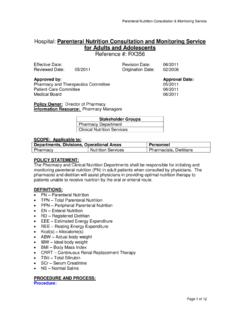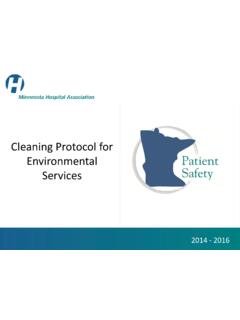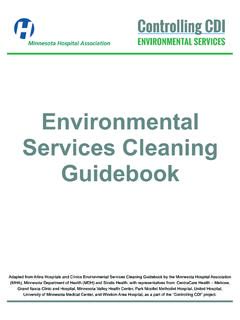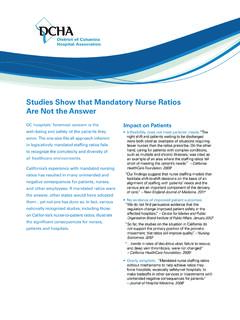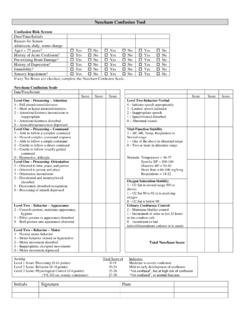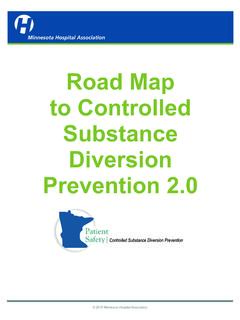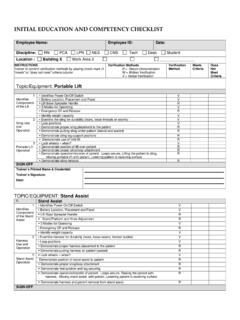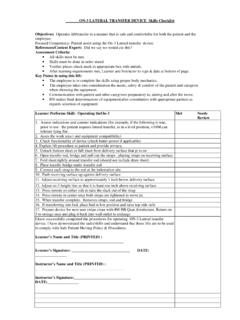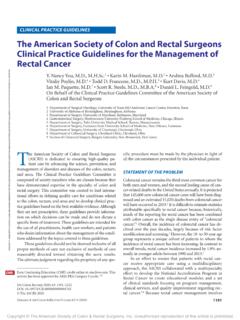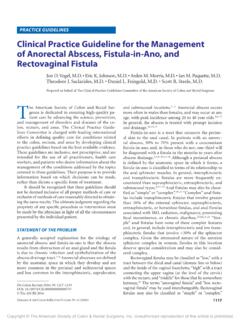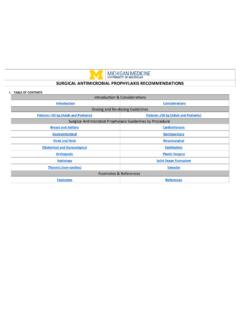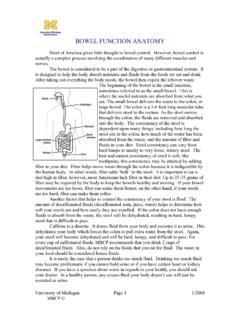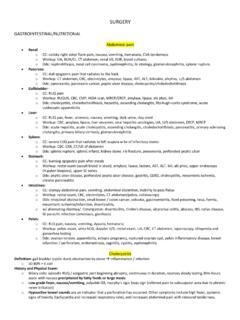Transcription of Directions for Use - mnhospitals.org
1 Directions for Use Faecal Management System Preparation of Device & Patient PRODUCT DESCRIPTION. The Flexi-Seal CONTROL . Faecal Management System contains: 1 soft catheter tube assembly, 1 Flexi-Seal Privacy collection bag with APS filter, 1 Luer-Lock Syringe, and 1 cinch clamp In addition to the device, gloves and lubricant will Securely attach the collection bag to the catheter Position the patient in left side lying position; if unable The soft catheter is inserted into the rectum for faecal management to contain and divert faecal waste in be required flange collar to tolerate, position the patient so access to the rectum order to protect the patient's skin and keep the bedding clean. is possible Remove any indwelling or anal device prior to insertion of the Flexi-Seal CONTROL device Perform a digital rectal exam to evaluate for contraindications INDICATIONS.
2 For use to manage faecal incontinence through the collection of liquid to semi-liquid stool and to provide Wearing the gloves, unfold the length of the catheter to access to administer medications as prescribed by a physician. lay it flat on the bed, extending the collection bag towards Insertion of Device the foot of the bed CONTRAINDICATIONS. 1. This product is not intended for use for more than 29 consecutive days for paediatric patients [patients under 18 years of age]. 2. The Flexi-Seal CONTROL Faecal Management System should not be used on individuals who: have suspected or confirmed rectal mucosal impairment, , severe proctitis, ischemic proctitis, Using the syringe provided, remove the air that is Insert a lubricated gloved finger into the blue finger Grasp the catheter and gently insert the balloon end Inflate the balloon with up to 45ml of fluid by slowly mucosal ulcerations in the balloon by attaching the syringe to the grey pocket for digital guidance during device insertion through the anal sphincter until the balloon is beyond depressing the syringe plunger have had rectal surgery within the last year inflation port (marked 45ml )
3 And withdrawing Coat the balloon end of the catheter with lubricant the external orifice and well inside the rectal vault With the insertion finger removed, the green have any rectal or anal injury the plunger The finger may be removed or remain in place in the SIGNAL indicator will expand once the balloon has have haemorrhoids of significant size and/or symptoms Remove the supplied syringe and fill it with 45ml of rectum during initial balloon inflation reached the optimal fill level for the anatomy have a rectal or anal stricture or stenosis water or saline and connect the syringe to the grey There may be cases where the SIGNAL indicator have a suspected or confirmed rectal/anal tumor inflation port of the catheter will not expand if the space in the rectum is large have any in-dwelling rectal or anal device Never fill with >45ml of fluid ( thermometer)
4 Or delivery mechanism ( suppositories or enemas) in place are sensitive to or who have had an allergic reaction to any component within the system PRECAUTIONS AND OBSERVATIONS. position indicator line 1. C. lose attention should be exercised with the use of the device in patients who have inflammatory bowel conditions or who have had rectal surgery . The physician should determine the degree and location of inflammation or extent of surgery ( location of anastomosis) within the colon/rectum prior to The Auto-Valve fill line will close when the Remove the syringe from the inflation port Position the length of the silicone catheter along the Hang the collection bag by the bead strap on the considering use of this device in patients with such conditions.
5 Appropriate volume has been introduced Gently pull on the soft catheter to check that the patient's leg, avoiding kinks and obstruction bedside at a position lower than that of the patient If the green SIGNAL indicator expands at less balloon is securely in the rectum and that it is Record the insertion date than 30ml of fluid, withdraw the fluid and reposition positioned against the rectal floor 2. Care should be exercised in using this device in patients who have a tendency to bleed from Regularly check for changes in the location of the balloon in the rectal vault either anti-coagulant / antiplatelet therapy or underlying disease. If signs of rectal bleeding occur, Note the distance of position indicator line relative to the position indicator line to determine if there is remove the device immediately and notify a physician.
6 Remove any indwelling or anal device prior to After repositioning, fill the balloon as described the patient's anus a need to reposition the balloon or device and insertion of the Flexi-Seal CONTROL FMS. above. The Auto-Valve fill line will close when the assess if risks have changed appropriate volume has been introduced 3. Notify a physician immediately if any of the following occur: Irrigation, Maintenance & Removal of Device Rectal pain Rectal bleeding Abdominal symptoms such as distension/pain BLUE catheter 4. Solid or soft-formed stool cannot pass through the catheter and will obstruct the opening. The use of the irrigation port device is not indicated for solid or soft-formed stool. 5. Small amounts of moisture or seepage around the catheter is anticipated.
7 To avoid skin irritation, initiate an appropriate institutional skin care protocol. At a minimum, the skin should be kept clean, dry and protected with a moisture barrier product. To irrigate the device, fill the syringe with water at Repeat irrigation procedure as often as necessary to Change collection bag as needed To remove the catheter from the rectum, the room temperature, attach the syringe to the blue maintain proper functioning of device Observe the device frequently for obstructions from retention balloon must first be deflated 6. If the catheter becomes blocked with faeces, it can be rinsed with water using the irrigation port only irrigation port (marked IRRIG. ) and slowly depress Flushing the device as described above is an optional kinks, solid faecal particles or external pressure Attach the syringe to the grey inflation port (see Directions for Use Irrigation of the Device ).
8 Do not use the 45ml grey inflation port to irrigate. If the plunger procedure for use only when needed to maintain the (marked 45ml ) and slowly withdraw all fluid obstruction of the catheter is due to solid stool, use of the device should be discontinued. Discard used collection bags according to Do not irrigate through the grey inflation port unobstructed flow of stool into the collection bag institutional protocol for disposal of medical waste from the retention balloon (marked 45ml ) If repeated flushing with water does not return the Disconnect the syringe and discard 7. I f the patient's bowel control, consistency and frequency of stool begin to return to normal, discontinue Record the volume of introduced irrigation water flow of stool through the catheter, the device should Grasp the catheter as close to the patient as use of the device.
9 As with the use of any rectal device, the following adverse events could occur: be inspected to ascertain that there is no external possible and slowly remove from the anus obstruction ( , pressure from body part or piece of Leakage of stool around the device equipment, or resolution of diarrhoea) Rectal/anal bleeding due to pressure necrosis or ulceration of rectal or anal mucosa If no source of obstruction of the device is detected, Peri-anal skin breakdown use of the device should be discontinued Temporary loss of anal sphincter muscle tone Infection Medication Administration (Dosage prescribed by physician) Sampling Bowel obstruction Perforation of the bowel 8. This device is for single use only and should not be re-used.
10 Re-use may lead to increased risk of infection or cross contamination. Physical properties of the device may no longer be optimal for intended use. GENERAL GUIDELINES. The device may be changed as needed to perform normal patient assessment. The device is not intended for use for more than 29 consecutive days. Prepare the device for the administration of Next, tighten the cinch clamp completely, by closing To collect a sample from the catheter, open the blue If the product package is damaged, do not use. medication, by flushing the irrigation line with 10mls of to the second closure position. You will hear a second sample port cap room temperature water click to confirm that the clamp is fully tightened. Ensure Press the tip of a catheter syringe through the slit Remove the black cinch clamp from the kit packaging.
